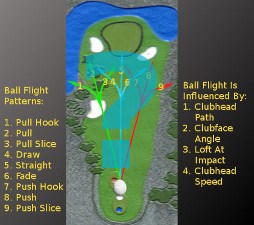
Pull Hook
A pull hook is a term used in golf to describe a specific type of shot where the ball starts left of the target (for a right-handed golfer) and then curves sharply to the left. It is a common mistake made by golfers, especially those with a steep or inside-out swing path.
Here are some key points to understand about the pull hook:
- The pull hook is usually unintentional and can be quite frustrating for golfers. It often results in a significant loss of distance and accuracy.
- It typically occurs when the golfer's clubface is closed at impact, meaning the face is pointing left of the target at the moment of contact with the ball.
- The excessive curve of the shot is caused by the combination of a closed clubface and an exaggerated inside-out swing path.
- A pull hook is likely to happen when a golfer attempts to hit the ball too hard or swings aggressively without proper control.
- The pull hook is primarily seen in shots with longer clubs, such as the driver or long irons, due to the higher swing speeds involved.
- It is important to note that a pull hook is different from a pull fade, which curves to the right for a right-handed golfer. Both shots start left of the target, but the pull hook curves severely to the left while the pull fade has a more controlled curve to the right.
To prevent or correct a pull hook, a golfer can focus on the following:
- Check and adjust the grip: The golfer should ensure that the grip is not too strong (hands turned too far to the right for a right-handed golfer). A neutral grip can help promote a square clubface at impact.
- Reposition the ball: Placing the ball slightly more forward in the stance can encourage a more outward swing path.
- Monitor the swing path: By working with a golf instructor or using swing analysis tools, golfers can identify if their swing path is too inside-out and make necessary adjustments.
- Practice proper weight transfer: By shifting the weight correctly during the swing, golfers can help promote a more on-plane swing path.
- Develop a smoother tempo: Swinging with excessive force or haste can contribute to a pull hook. Golfers should strive for a balanced and controlled swing.
- Consider clubface control: Maintaining awareness of the clubface throughout the swing is crucial. Practicing drills focusing on squaring the clubface at impact can improve shot consistency.
- Seek professional guidance: If the pull hook persists or becomes a recurring issue, seeking help from a golf instructor is recommended. They can provide personalized guidance and drills to address the problem.
Remember, correcting a pull hook takes practice and patience. By working on the underlying causes and making necessary adjustments, golfers can reduce the occurrence of this frustrating shot and improve their overall game.





